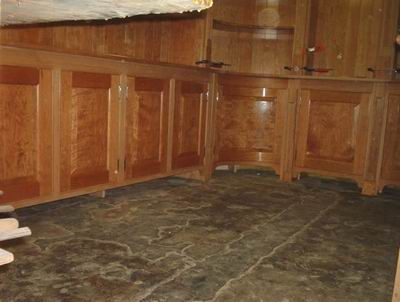Cleaning Glue Off Melamine After Edge-Banding
"Hot" solvents can dull melamine or leave a combined glue-and-thinner residue behind. Here are some suggested solutions. February 26, 2007
Question
I am using a hot air bander. When my panels come out, they have excess glue remaining on the panel. I found that some lacquer thinner does a great job of cleaning it off, but it ate at the melamine, leaving a dull appearance where it was wiped. What is the best method for removing this glue without leaving a residue, scratching the panel or dulling the surface? (A new machine is not an option.)
Forum Responses
(Cabinetmaking Forum)
From contributor L:
Try denatured alcohol, or acetone.
From contributor P:
I've never had melamine react to lacquer thinner - check that your cutter isn't cutting a little off the melamine surface, thus dulling it. We use 3M's citrus-based adhesive spray cleaner - quick, efficient, no thinner fumes, way nicer for onsite work.
From the original questioner:
I had been using lacquer thinner with no problems until yesterday when a customer complained that there were streak marks around the edges of her new garage cabinet doors. They are only visible in bright light. I scrubbed them with 409, soft scrub, water and even more lacquer thinner and still could not get rid of them. I will try your solutions. Thanks.
From contributor H:
I have been using thinner for years and can still spell and type this posting! Never had a problem with streaking. Double check trimmer, as previous post mentioned. I think that is the source of the problem.
From contributor G:
I've had experience with an extra-cheap type of melamine where the white actually wiped off with lacquer thinner. There are different grades of melamine, apparently. Different grades of thinner, too. Use one that evaporates quickly so it won't have time to bite in to the melamine you have.
From contributor M:
Lacquer thinner and denatured alcohol are too hot for melamine. If you spend too much time in one spot, it can burn through. There are solvents for contact adhesive that work well. They are similar in strength to mineral spirits. Try either of these, but don't soak the edge or it will release. Yes, it does take longer, but the finish will remain intact.
From contributor S:
My guess is that the streaks are caused by the glue you are trying to remove dissolving into the lacquer thinner and that combination is not being completely wiped off. Lacquer thinner will not leave a residue by itself, but if mixed with glue residue, it will. The problem is that to completely wipe off the combination, you have to use a clean rag or paper towel and do it very quickly before the lacquer thinner dries. If you want as quick a glue-dissolving action as lacquer thinner gives, but more time to wipe it off, use lacquer retarder available at a paint store.
The comments below were added after this Forum discussion was archived as a Knowledge Base article (add your comment).
Comment from contributor A:
I'd like to leave comments about a few issues raised in this post. Different types of melamine: Be careful which type of product you are using, there are painted surfaces and there are surfaces which have a paper adhered to it. The paper product has much higher resistance to thinners. When we use painted products for drawer bottoms, we can accidentally white the paint right off, if we are not careful.
Secondly, I also have issues with lacquer thinner leaving streaks on finished products. I'm currently testing how to get rid of the streaks. The important contribution I'd like to make to this discussion: There is no edge banding glue on the board. I'm using a piece of scrap black melamine board and I'm using Valspar lacquer thinner (YYT 1090) and I'm getting streaks.
If I'm not mistaken, lacquer thinner - as the name suggests - is an oil product with very low viscosity, meant to thin oil based paint. This means the lacquer thinner itself may leave a slight oil film behind, which is what we see as streaks.
